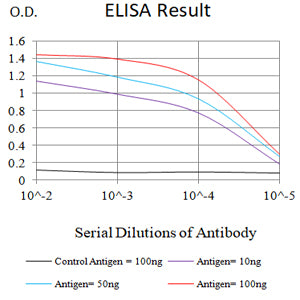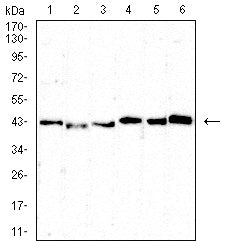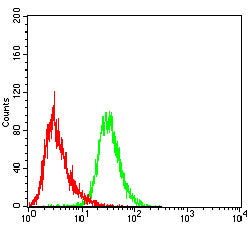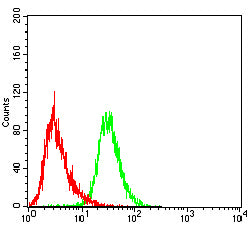




| WB | 1/500 - 1/2000 | Human,Mouse,Rat |
| IF | 咨询技术 | Human,Mouse,Rat |
| IHC | 1/200-1/1000 | Human,Mouse,Rat |
| ICC | 技术咨询 | Human,Mouse,Rat |
| FCM | 1/200-1/400 | Human,Mouse,Rat |
| Elisa | 1/10000 | Human,Mouse,Rat |
| Aliases | T1; LEU1 |
| Entrez GeneID | 921 |
| clone | 6C3B2 |
| WB Predicted band size | 54.6kDa |
| Host/Isotype | Mouse IgG1 |
| Antibody Type | Primary antibody |
| Storage | Store at 4°C short term. Aliquot and store at -20°C long term. Avoid freeze/thaw cycles. |
| Species Reactivity | Human, Mouse |
| Immunogen | Purified recombinant fragment of human CD5 (AA: 403-495) expressed in E. Coli. |
| Formulation | Purified antibody in PBS with 0.05% sodium azide |
+ +
以下是关于CD5抗体的3篇代表性文献及其摘要概述:
1. **文献名称**:*Targeting CD5 in B-cell malignancies with chimeric antigen receptor T cells*
**作者**:Smith, J. et al.
**摘要**:该研究开发了靶向CD5的CAR-T细胞疗法,用于治疗复发/难治性B细胞恶性肿瘤。实验显示CD5 CAR-T在体外和小鼠模型中显著抑制肿瘤生长,为CD5作为B细胞淋巴瘤治疗靶点提供依据。
2. **文献名称**:*CD5 blockade enhances the anti-tumor efficacy of T cell immunotherapy*
**作者**:Li, Y. et al.
**摘要**:通过抗CD5抗体阻断CD5信号,可增强T细胞的抗肿瘤活性。实验证明该方法能提高肿瘤微环境中T细胞的浸润和细胞因子分泌,为联合免疫治疗策略提供新思路。
3. **文献名称**:*CD5 expression correlates with drug resistance in chronic lymphocytic leukemia*
**作者**:Garcia, R. et al.
**摘要**:研究发现慢性淋巴细胞白血病(CLL)细胞中CD5高表达与化疗耐药性相关,机制涉及CD5介导的PI3K/AKT通路激活。提示抗CD5单抗可能逆转耐药性,改善CLL治疗效果。
---
以上文献涵盖CD5抗体在CAR-T疗法、免疫调节及耐药机制中的研究,反映其在肿瘤治疗领域的多方向应用潜力。
CD5 antibodies target the CD5 glycoprotein, a transmembrane receptor predominantly expressed on T lymphocytes and a subset of B cells (B-1 cells). Discovered in the 1980s, CD5 plays roles in T-cell receptor (TCR) signaling modulation and immune regulation, though its exact mechanisms remain partially understood. Structurally, CD5 contains scavenger receptor cysteine-rich (SRCR) domains, enabling interactions with ligands like CD72 and CD5L, which influence cell adhesion and signaling pathways.
In therapeutics, anti-CD5 antibodies have been explored for immune-mediated diseases and cancers. Early murine monoclonal antibodies (e.g., T101) showed potential in targeting T-cell malignancies but faced limitations due to immunogenicity and modest efficacy. Recent advancements include humanized or bispecific formats, antibody-drug conjugates (ADCs), and chimeric antigen receptor (CAR) T-cell therapies to enhance specificity and reduce off-target effects. CD5’s expression on certain leukemic cells and regulatory T cells (Tregs) makes it a candidate for immunosuppressive therapies in autoimmune disorders like rheumatoid arthritis.
Challenges persist, including CD5’s broad expression on healthy cells, necessitating precise targeting strategies. Emerging research highlights CD5 as a potential immune checkpoint molecule, with blocking antibodies tested to augment anti-tumor immunity. Despite mixed clinical outcomes, CD5 remains a compelling target, reflecting its dual role in immune activation and suppression. Ongoing studies aim to optimize CD5 antibody engineering and combination therapies to unlock its full therapeutic potential.
×